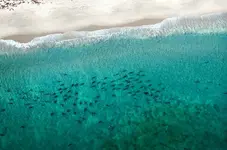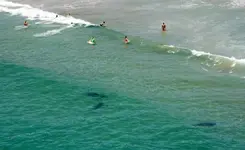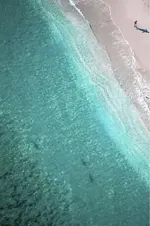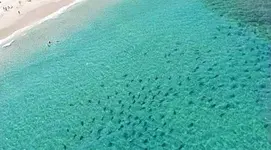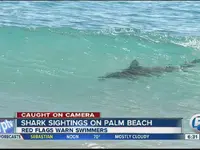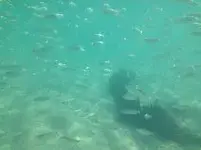You are using an out of date browser. It may not display this or other websites correctly.
You should upgrade or use an alternative browser.
You should upgrade or use an alternative browser.
Florida Sharks
- Thread starter lost items recovery
- Start date
Sir Gala Clad
Bronze Member
There are about 100 million shark attacks, each year — roughly 11,00 attacks per hour.Theese
numbers may be on the low side, since this this number is based on the number recorded.
If you dine at a large sea food restaurant, you may see 50 to 100 man, woman, and even children eating sharks while you are dining. If I was a shark, I would be terrified. That’s not even including the thousand of my buddies who have been waisted dangling on long lines or trapped in nets.
Of the more than 450 different types of sharks only a few are harmful to man, such as the bull shark, tiger shark, hammer head shark, you fill in the blank, close to shore in Florida waters. In my opinion, the bull shark is the most dangerous as it can live in brackish waters including fresh water rivers. If you look at the teeth of a tiger shark you can see that they are chiseled, for breaking shells of turtles. A word to the wise — don’t go out past the furthest out sand bar and avoid looking like a turtle which bogy do, especially when wearing short flippers on hand or feet to catch the waves. A hammer head shark has pointed cat like teeth, all the better for holding, so if a victim is attached, you can haul both the victim and shark back to shore.
I did not include the Great White shark, as it is heavily tracked and reported.
Most victims are released after an exploratory mistaken bite, so survival rate is surprisingly high.
You can tell from it’s triangular teeth that it mostly feeds on pinapods (seals).
Nor did I include the Mako, which is morely to hit a shiny propeller on a boat.
You will find this shark where the tuna roam. Speak of irony both of these apex predators
are on the threathened list.
Also, please do not bother the sharks, even a nurse shark — which does not have teeth, can gum you to
Death if you annoy it. The same is for dolphins, which may ram you with their head if you annoy them
Or confuse their sonar.
When you use the ocean for recreation, you have to realize that you are entering a shark’s world.
Knowledge and a little respect will go a long way in keeping you out of trouble.
While those pictures are sensational, they forgot to identify the type of shark photographed.
Looks like small grey sharks or spinner shark to me.
Personally, I am more scared of walking barefoot on the beach (broken bottles, sharp can lids, fish hooks, nasty staff infections — if you get cut). Then you have to worry about the sun turning you into a crispy critter or burning the bottom of your feet when the sand heats up.
Take care and have a great day, don’t forget to buckle up on your drive to and from the beach which is the greatest danger, or getting run over if you walk to the beach in Hawaii
numbers may be on the low side, since this this number is based on the number recorded.
If you dine at a large sea food restaurant, you may see 50 to 100 man, woman, and even children eating sharks while you are dining. If I was a shark, I would be terrified. That’s not even including the thousand of my buddies who have been waisted dangling on long lines or trapped in nets.
Of the more than 450 different types of sharks only a few are harmful to man, such as the bull shark, tiger shark, hammer head shark, you fill in the blank, close to shore in Florida waters. In my opinion, the bull shark is the most dangerous as it can live in brackish waters including fresh water rivers. If you look at the teeth of a tiger shark you can see that they are chiseled, for breaking shells of turtles. A word to the wise — don’t go out past the furthest out sand bar and avoid looking like a turtle which bogy do, especially when wearing short flippers on hand or feet to catch the waves. A hammer head shark has pointed cat like teeth, all the better for holding, so if a victim is attached, you can haul both the victim and shark back to shore.
I did not include the Great White shark, as it is heavily tracked and reported.
Most victims are released after an exploratory mistaken bite, so survival rate is surprisingly high.
You can tell from it’s triangular teeth that it mostly feeds on pinapods (seals).
Nor did I include the Mako, which is morely to hit a shiny propeller on a boat.
You will find this shark where the tuna roam. Speak of irony both of these apex predators
are on the threathened list.
Also, please do not bother the sharks, even a nurse shark — which does not have teeth, can gum you to
Death if you annoy it. The same is for dolphins, which may ram you with their head if you annoy them
Or confuse their sonar.
When you use the ocean for recreation, you have to realize that you are entering a shark’s world.
Knowledge and a little respect will go a long way in keeping you out of trouble.
While those pictures are sensational, they forgot to identify the type of shark photographed.
Looks like small grey sharks or spinner shark to me.
Personally, I am more scared of walking barefoot on the beach (broken bottles, sharp can lids, fish hooks, nasty staff infections — if you get cut). Then you have to worry about the sun turning you into a crispy critter or burning the bottom of your feet when the sand heats up.
Take care and have a great day, don’t forget to buckle up on your drive to and from the beach which is the greatest danger, or getting run over if you walk to the beach in Hawaii
Last edited:
Where are you getting your figures?
G.I.B.
Gold Member
- Joined
- Feb 23, 2007
- Messages
- 7,187
- Reaction score
- 8,539
- Golden Thread
- 0
- Location
- North Central Florida
- 🏆 Honorable Mentions:
- 1
- Detector(s) used
- CTX 3030 / GTI 2500 / Infinium LS / Tesoro Sand Shark / 1 Garrett Pro-pointer / 1 Carrot / Vibra Probe 580 (out on loan) / Lesche M85 / Mark1 MOD1 EyeBall
- Primary Interest:
- Other
Jaws, the unabridged version.
It's actually a recipe book for eating humans.
They have charts, people tables (similar to tide tables but for people in the surf) and a leg identification guide.
They are publishing a new book next year that has a lot of tips for sneaking up on the tender nuggets, (kids) and how to avoid the people with a high fat content.
I don't want to tell anybody where, but we have been training a Cougar to ride a Tiger Shark. (new tourist attraction)

It's actually a recipe book for eating humans.
They have charts, people tables (similar to tide tables but for people in the surf) and a leg identification guide.
They are publishing a new book next year that has a lot of tips for sneaking up on the tender nuggets, (kids) and how to avoid the people with a high fat content.
I don't want to tell anybody where, but we have been training a Cougar to ride a Tiger Shark. (new tourist attraction)

This is the lots of bait I prefer.....
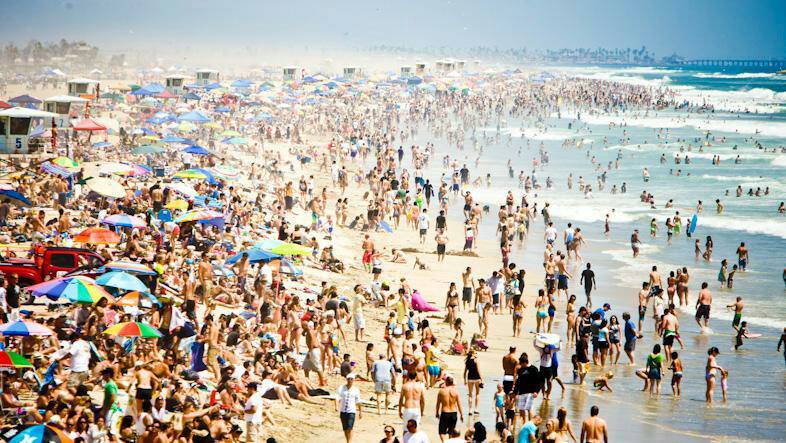

MrMikeJackie
Bronze Member
- Joined
- Nov 3, 2013
- Messages
- 1,751
- Reaction score
- 2,258
- Golden Thread
- 2
- Location
- Long Island
- 🥇 Banner finds
- 2
- 🏆 Honorable Mentions:
- 1
- Detector(s) used
- CTX 3030,
Xp Deus,
That's it, I'm done.
- Primary Interest:
- Metal Detecting
6 shark attacks in NC the past 2 weeks. 2 in OBX. I believe it happens a lot more then we are led to believe. No city/state officials are willing to admit the true numbers, especially recently. Too much money is at stake. We laugh but it's basically the beginning premise to the movie Jaws all over again.
If there were shark attacks local new stations would be reporting it just like they are in Florida..
MrMikeJackie
Bronze Member
- Joined
- Nov 3, 2013
- Messages
- 1,751
- Reaction score
- 2,258
- Golden Thread
- 2
- Location
- Long Island
- 🥇 Banner finds
- 2
- 🏆 Honorable Mentions:
- 1
- Detector(s) used
- CTX 3030,
Xp Deus,
That's it, I'm done.
- Primary Interest:
- Metal Detecting
Of course they are, but that's it. It doesn't go any farther than local. I'm just saying that the data base numbers in which "we" base our opinions on are a "bite" off 

If they are reported only locally you could still find them on internet search even if only locally reported....Of course they are, but that's it. It doesn't go any farther than local. I'm just saying that the data base numbers in which "we" base our opinions on are a "bite" off
G.I.B.
Gold Member
- Joined
- Feb 23, 2007
- Messages
- 7,187
- Reaction score
- 8,539
- Golden Thread
- 0
- Location
- North Central Florida
- 🏆 Honorable Mentions:
- 1
- Detector(s) used
- CTX 3030 / GTI 2500 / Infinium LS / Tesoro Sand Shark / 1 Garrett Pro-pointer / 1 Carrot / Vibra Probe 580 (out on loan) / Lesche M85 / Mark1 MOD1 EyeBall
- Primary Interest:
- Other
OBN
Gold Member
- Joined
- Dec 30, 2008
- Messages
- 6,583
- Reaction score
- 7,139
- Golden Thread
- 0
- Location
- Maryland Waters
- 🏆 Honorable Mentions:
- 1
- Detector(s) used
- "Excalibur"..
"AQ" Impulse
- Primary Interest:
- Other
LOLI was on south beach this past Sunday and I had a 5 to 6 foot shark approach me!!! I was in waist high water and I had to nudge it away my scoop. I tell you the water ran yellow as i did that and I high tailed it out of the water.......of course 20 min later I was back in it again.
I had the same with a skate last week, came in close and caught me off guard, murky water did not help.. so I went in for about 10 minutes to gain my composure..
lost items recovery
Bronze Member
- #32
Thread Owner
LOL - good luck with that.
You have more chance of getting killed in a car accident driving to the beach than getting bit by a shark.
Tell that to the two teens that just got bit in North Carolina.
Besides I drive really careful so I'll probably get bit
lost items recovery
Bronze Member
- #33
Thread Owner
I'm going to rub my self down in tuna fish just to prove you wrong! Lol
Sir Gala Clad
Bronze Member
Animals - HowStuffWorksWhere are you getting your figures?
Article “How many sharks are killed recreationally each year—and why?
“Research indicates that about 100 million sharks are killed each year by humans -- roughly 11,000 sharks every hour, around the clock [source: HSUS]. These numbers may even be on the low side, since the estimate is based only on the reported catch numbers. It's likely that many sharks are caught without being reported”
Commercial fishing accounts for a large part of the overall number of sharks caught. Sometimes the shark is the target, but many times it's just a victim of something called bycatchCommercial fishing accounts for a large part of the overall number of sharks caught. Sometimes the shark is the target, but many times it's just a victim of something called by catch.
Note: I extracted the information from above article– did not directly quote it, as I wanted to present the above information from a sharks point of view, to reflect that man is the predator and sharks have a lot to fear from man.
The number of people eating shark at a seafood restaurant is my guest mate, a wild one at that.
I know that shark is a popular item on the menu as it is firm and cheaper, also the scallops being eaten may have actually been punched out of the wing tips of a bat ray.
Entangled in nets – personal experience: I had become entangled in a net near the harbor at Rock Port Mass around 1966, while diving for lobster (I had a commercial license) in murky water.
Not wanting to damage the net, I struck the side of my aqua lung several times with my diving knife
To alert my diving partner that I needed help. While waiting for my diver partner to come to my aide I realized that there were several shark (approx 4 to 6 ft long) entangled in this net. Speak of scary in the limited visibility, and the angle of approach, I could not tell if what was approaching me was a shark or my partner (sigh).
Shark Facts and Information and www.shark-sider.com identify 400 to 450 types of sharks, stating that only a few are harmful to man.
(IUCN - Home)
IUCN experts classify the Great Hammerhead (Sphyrna mokarran) and Scalloped Hammerhead (Sphyrna lewini) sharks, as well as Giant Devil Rays (Mobula mobular), as globally Endangered. Smooth Hammerheads (Sphyrna zygaena), Great White (Carcharodon carcharias), Basking (Cetorhinus maximus) and Oceanic Whitetip (Carcharhinus longimanus) sharks are classed as globally Vulnerable to extinction, along with two species of Makos (Isurus spp.) and three species of Threshers (Alopias spp.).
Numerous news paper articles and personal experience, learned fishing and diving with shark in the water (numerous times, but not on purpose in California, Mexico, Gulf – Mississippi to Florida Panhandle, and Gulf and Atlantic at the Florida Keys, as well as New England.
Sir Gala Clad
Bronze Member
Where are you getting your figures?
Planet Deadly “Most Dangerous Sharks” I did not use this as a reference, as I was not aware of it. I highly recommend it as a resource, it features the 10 most dangerous sharks, with outstanding pictures of each and a very detailed write up. The ten most dangerous sharks from least to most dangerous in attacks and fatalities are: 1. Hammerhead shark (34 attacks, 1 Fatality), 2. Blacktip shark (41 attacks, 1 Fatality) 3. Sand Tiger Shark (64 attacks, 2 Fatalities), 4. Blue Shark (32 attacks, 4 Fatalities), 5. Bronze whale shark (35 attacks, 2 Fatalities), 6. Shortfin Mako Shark (45 attacks, 3 Fatalities), 7. Oceanic Whitetip (Attacks unknown, Fatalities many), 8. Tiger Shark 155 attacks, 29
Fatalities, 9. Bull shark,aka Ganges shark, Nicaragua shark, river shark, Swan River Whaler, shovelnose, bull whaler, and Van Rooyen’s Shark (104 attacks, 26 Fatalities, 10. Great White Shark, aka White Pointer (400 plus attacks, 74 fatalities)
Additions/ Conflicts/ Corrections to what I posted follow:
1. Hammer Head teeth similar to those of a bull shark. This conflicts with news paper article, maybe because of size or different
specie of Hammer Head.
2. Blacktip sharks are not generally regarded as being very dangerous to Humans owing to their size. But they are frequent attackers, making up the highest percentage of shark attacks in Florida.
3. Blue Shark is a member of the requiem shark family.
4. Bronze Whaler – most prominent during the annual sardine run in South Africa. There have been a number of unprovoked attacks on swimmers and surfers along the coast of Australia.
3. Tiger shark, aka the garbage can of the sea as it commonly swallows anything it comes across with a proportionately wider mouth than other sharks lined with serrated teeth perfect for slicing prey as opposed to gripping like many sharks.
9. Bull shark,aka Ganges shark, Nicaragua shark, river shark, Swan River Whaler, shovelnose, bull whaler, and Van Rooyen’s Shark. What makes bull sharks particularily dangerous to humans is the likelihood of crossing paths with one of these brutes is higher than any other of the dangerous sharks. Not only does the bull shark live in shallow coastal waters it can do something most other sharks cannot – tolerate fresh water. The sharks have specially adapted kidneys which allow them to travel thousands of miles up river and even live in lakes where it has also claimed its victims in addition to salt water.
These sharks occur in all the oceans of the world and tolerate water temperatures between 12 and 24°C (54 and 75 °F). They can be found in deep water or near the coast, generally around seal colonies. Great whites are most concentrated around the shores of South Africa, Australia, Northeast USA, California, Japan and the Mediterranean. That last one surprises a lot of people, especially as there have been over 30 recorded attacks in the Med
“
G.I.B.
Gold Member
- Joined
- Feb 23, 2007
- Messages
- 7,187
- Reaction score
- 8,539
- Golden Thread
- 0
- Location
- North Central Florida
- 🏆 Honorable Mentions:
- 1
- Detector(s) used
- CTX 3030 / GTI 2500 / Infinium LS / Tesoro Sand Shark / 1 Garrett Pro-pointer / 1 Carrot / Vibra Probe 580 (out on loan) / Lesche M85 / Mark1 MOD1 EyeBall
- Primary Interest:
- Other
Tell that to the two teens that just got bit in North Carolina.
Teens? Hell, I've got underwear older than them. How attached can you get to a teenager anyhow?
The sharks didn't think they were very tasty either... spit 'em right back out.
lost items recovery
Bronze Member
- #37
Thread Owner
LolTeens? Hell, I've got underwear older than them. How attached can you get to a teenager anyhow?
The sharks didn't think they were very tasty either... spit 'em right back out.
sponge
Bronze Member
Shes done.
sent from a sending device
Shes done.
sent from a sending device
sent from a sending device
Boatlode
Bronze Member
- Joined
- Mar 30, 2014
- Messages
- 1,729
- Reaction score
- 3,039
- Golden Thread
- 0
- Location
- Florida Treasure Coast
- Detector(s) used
- Tesoro Sand Shark......
Nokta Pulse dive....
Scubapro Jet Fins...................
Mares Puck dive computer.......
Sherwood Silhouette BCD.......
Poseidon Cyklon 300 regulator...
- Primary Interest:
- Shipwrecks
Tell that to the two teens that just got bit in North Carolina.
Besides I drive really careful so I'll probably get bit
Two shark bites. And how many million people were in the water that day on the east coast?
Similar threads
- Replies
- 2
- Views
- 349
- Replies
- 15
- Views
- 375
- Replies
- 14
- Views
- 2K
Users who are viewing this thread
Total: 1 (members: 0, guests: 1)

